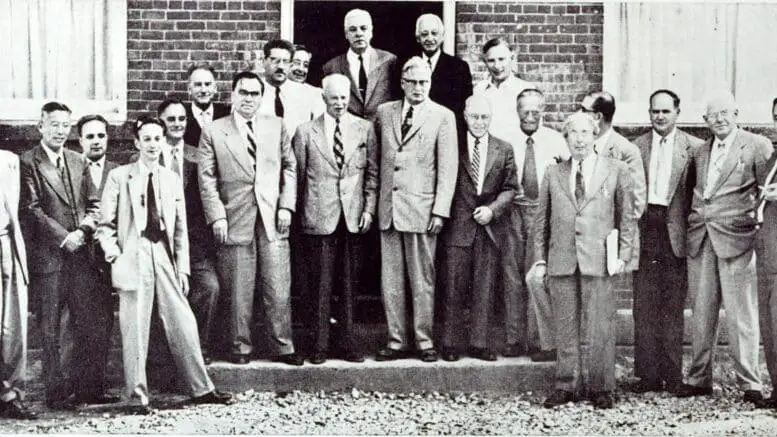Gerson S Sher, From Pugwash to Putin: A Critical History of US–Soviet Scientific Cooperation. Indiana University Press, Bloomington, IN, 2019. 318 pp., $80.84 hb. ISBN-13 978-0253042613
Following the death of Joseph Stalin, science and its relationship with politics entered a transformative period in both the United States and Soviet Union. Science became a state apparatus to build diplomatic relations and acquire technology across transnational lines. How the U.S. government appropriated university structures and non-state organizations to achieve these ends, and how the two world powers’ use of science evolved within the Cold War, is well demonstrated in Gerson S. Sher’s From Pugwash to Putin: A Critical History of US-Soviet Scientific Cooperation. Sher articulates these concepts through an extensive explanation of the Lacy-Zarubin agreement in 1958 and the Brezhnev-Nixon summits in 1972.
Stalin’s successor, Nikita Khrushchev, showed immense promise in advancing diplomatic efforts between the U.S. and the Soviet Union. In 1956, Khrushchev’s infamous Secret Speech lambasted Stalin’s character, policies, and leadership capacity to fellow Communist Party members during a closed session for the Twentieth Congress of the Communist Party of the Soviet Union. Khrushchev pledged that the Party would no longer engage in terror, heavy censorship, and isolation from the world stage. Moreover, the Party would dismantle Stalin’s ‘cult of personality,’ which enabled Stalin’s tyrannical reign. Effectively, Khrushchev’s primary agenda as the new premier of the Soviet Union was to ‘de-Stalinize’ the state by gradually democratizing the Party and erasing Stalin’s influence.
Incongruously with its name, the contents of the Secret Speech would rapidly circulate to American officials. The Twentieth Congress transpired from February 14 to February 25, with American diplomats authorized to attend some open sessions. However, it seems that diplomats quickly ascertained the speech’s contents, despite it having been delivered at a closed session.
Within mere weeks of the Secret Speech, American scholars took advantage of these rumors to actualize transnational academic cooperation. The Secret Speech alerted scholars that the Soviet Union was entering an era wherein the Communist Party would permit freer interactions between Americans and Soviets. With financial assistance from the Ford Foundation, the Inter-University Committee on Travel Grants, or the IUCTG, was created to assist U.S. and Soviet scholars in obtaining tourist visas and stipends to study abroad (Sher 15, 262). Sher highlights the creation of the IUCTG as a critical moment. This is because the Central Committee and other actors in the Communist Party permitted the Soviet Union’s university system and Academy of Sciences to engage with the IUCTG, thereby displaying a commitment to de-Stalinization and democratization (Sher, 262).
Consequently, the IUCTG’s success led scientists worldwide to push the envelope further in terms of transnational cooperation. Foremost, they prioritized capitalizing on Khrushchev’s thaw to de-escalate the arms race. In 1955, the Russell-Einstein Manifesto raised concerns about nuclear weapons’ capabilities to decimate humanity (Sher, 11-15). The U.S. and the Soviet Union possessed nuclear weapons, the U.S. since 1945 and the Soviet Union since 1949, with ever-growing stockpiles. An understanding formed that if the U.S. or the Soviet Union were to launch a nuclear attack, the recipient country would retaliate, resulting in mutually assured destruction.
Seeking to mitigate such an outcome, in 1957, Canadian American philanthropist Cyrus Eaton sponsored a conference out of his Nova Scotian home for 28 independent scientists and academics from the Soviet Union, the U.S., and other world powers (Sher 10-11). The gathering in Eaton’s home became known as the first Pugwash Conference, a name chosen to honor the Nova Scotian village where Eaton’s home was located. The legacy of the first conference would persist with the establishment of the Continuing Committee for the Pugwash Conferences on Science and World Affairs in the same year (Sher, 10-13). Pugwash Conferences offered a platform to discuss nuclear weapons, energy, management of fissile materials, and the Cold War in a less politically charged environment, fostering a diplomatic atmosphere that facilitated peaceful discussion and exchange of research (Sher, 10-13).
To comprehend how unprecedented the IUTCG and the Pugwash conferences were, as well as the forces that enabled their existence, context is required. Before the Secret Speech, bilateral collaboration did, to a limited extent, exist between the U.S. and the Soviet Union. During World War II, the Party enabled Soviet scientists to collaborate with foreign scientists within the Anti-Fascist Grand Alliance. However, as World War II ended and the Cold War began, avenues for open collaboration closed off (Pollock, 5). Stalin, from 1946 to his death in 1953, held revolving sessions in the Central Committee to discuss the ideological implications of various scientific disciplines. Fields rooted in Western thought and structured around an idealist understanding of the world were labeled as Anti-Soviet. Consequently, those fields were tightly regulated, defunded, or, in the case of the field of genetics, banned entirely (Pollock, 52). Further, to effectively consolidate power and maintain the stability of the Party’s legitimacy, exchanges of ideas on the international stage, from cultural to academic, were restricted due to their ‘cosmopolitan’ nature. The Soviet government and Communist Party derived national cohesion from propping up an antithetical view between the East and West, which vilified Western powers and sanctified Soviet power. International cooperation and the endorsement of Western-based science could disrupt such perspectives by exposing the Soviet people to a competing perspective of the West and capitalism.
While Stalin’s strategy of isolationism strengthened the sense of a distinct Soviet identity and stabilized Party legitimacy, isolationism slowed innovation and industrialization to a crawl; thus, the Soviet economy contracted. To reinvigorate the economy, the Soviet Union had to reconnect itself with the outside world to import technology and expand trade, hence the contents of the Secret Speech. Khrushchev’s commitment to openness and liberalization was partially motivated by economic ends (Sher, 9-11). To uphold progress, Marxist-Leninist dogma, as postulated by Stalin, had to be compromised so that innovation within the sciences could occur uninhibited and trade opportunities could be maximized. These conditions led to the Communist Party authorizing Soviet academics and scientists to engage with the IUCTG and the Pugwash Conferences. Furthermore, as argued by Sher, the grassroots nature of the IUCTG and the Pugwash Conferences eased Party fears of conforming to the U.S. government’s terms of cooperation. In actuality, due to the IUCTG and Pugwash Conferences’ grassroots origins with the American scientists who organized these agreements not beholden to the U.S. government, the Soviet government was able to maintain leverage to negotiate the terms and conditions of many of these interactions (Sher, 261-2). Consequently, the Soviet government was able to arrange the IUCTG to be consistent with their Soviet aims.
On October 4, 1957, the Soviet Union successfully launched Sputnik into outer space, causing American policymakers to become paranoid of the Soviet Union’s technological capabilities. These fears of technological inadequacy combined with economic aspirations and the ability of autonomous institutions to facilitate scientific collaboration. This all eventually pushed American President Dwight D. Eisenhower’s special assistant on East-West exchanges, William S. B. Lacy, and the Soviet ambassador to the U.S., Georgi Z. Zarubin, to sign the Lacy-Zarubin Agreement on January 27, 1958 (Sher 13-15). The Lacy-Zarubin Agreement was a bilateral agreement enabling research exchange in fields varying from the hard sciences, such as biology, to more culturally oriented disciplines, such as dance. To implement the Lacy-Zarubin Agreement in the realm of science, exchange programs were instituted alongside channels to share research data.
The IUCTG provided infrastructure for Lacy-Zarubin, and its networks were appropriated by the U.S. Department of State to facilitate exchange between American and Soviet scholars. Until 1968, when the IUCTG was consolidated by the U.S. Department of State’s Bureau of Educational and Cultural Affairs into the International Research and Exchanges Board Program, exchanges per Lacy-Zarubin were overseen by the American university system and Soviet state organs (Sher, 15). Yale Richmond, who oversaw the Bureau of Educational and Cultural Affairs’ Soviet-American program and was interviewed by Sher, explained that the early organization of Lacy-Zarubin was centered around “…[s]atisfying the Soviets’ obsession with control” in order to access their technology and avoid escalation (Sher, 14).
The status quo of bilateral scientific cooperation, as arranged in Lacy-Zarubin, would remain largely unchanged until the 1972 Nixon-Brezhnev summits in Beijing and Moscow (Sher 21-23). At the summits, American President Richard Nixon and then leader of the Soviet Union Leonid Brezhnev met to negotiate and compromise on issues pertaining to the peaceful dissolution of the Cold War (Sher, 21-23). Brezhnev entered the summits at a disadvantage, as issues surrounding the Soviet economy and its industrialization persisted. However, he hoped to garner greater access to foreign technology and trade, which became limited following the Cuban Missile Crisis in 1962. Since Yuri Gagarin’s orbit around the Earth in 1961, the Soviet Union failed to produce a scientific breakthrough of similar ingenuity. Additionally, academic fields that the Soviet Union was previously renowned for, such as mathematics, lost their luster from systematic corruption compromising their integrity (Bunce, 149).
The U.S., by 1972, was assured in its technological capacities and secure in its world power status, whereas the Soviet Union was not. Moreover, the U.S. was well aware of the Communist Party’s growing insecurity, which gave Nixon leverage when negotiating with Brezhnev during the summits, causing bilateral scientific collaboration between the world powers to be organized in line with U.S. interests, unlike during Lacy-Zarubin. The U.S. transformed scientific collaboration into a tool to force diplomacy. The U.S. threat to withdraw collaborative efforts created what former Secretary of State Henry Kissinger would refer to as ‘incentives for restraint,’ which pressured the Soviet Union to conform to American aims (Sher, 23, 153). Essentially, the power dynamic of Lacy-Zarubin was flipped. The Soviet mirage of economic and technological might dissipated. From this dynamic, Brezhnev was cornered into agreeing to the Strategic Arms Limitation Treaty at the Nixon-Brezhnev summit in Moscow and further reductions later (Sher, 21). The U.S. would maintain the upper hand in diplomacy with the Soviet Union through threats to withdraw scientific collaboration and exchange that persisted until the collapse of the Soviet Union in 1991 (Sher, 275).
Throughout the Cold War, science, with its potential to dually propel modernization and annihilate humankind, drove diplomatic efforts between the U.S. and the Soviet Union. Underpinning these governments’ use of science to drive foreign policy outcomes were bottom-up initiatives spurred by independent scientists, who wished to advance science for its own sake and as a way to maintain peace. Underlying elements, such as domestic economic performance and technological pageantry, shaped which country was privileged with making demands and which was forced to make concessions at different points in time. Sher’s work illuminates the underrepresented history of initiatives to advance cooperative efforts between American and Soviet scientists, breaking the myopic viewpoint of American and Soviet sciences existing in two discrete camps. Furthermore, Sher lays out how science acted as a mechanism in forwarding diplomatic efforts, underscoring an overlooked element in constructing diplomatic policy. Although in my reading of Sher, he accomplished these ends, to a reader not well versed in Soviet history, or lacks supplemental material to clarify aspects of Sher’s historical analysis, would likely fail to come to similar conclusions. This is because Sher, at multiple points in his work, fails to provide adequate background or elaborations of key historical events. For example, when Sher describes the creation of the IUCTG, he does not provide a clear timeline between Khrushchev’s Secret Speech and the IUCTG’s founding, conceivably resulting in the minimization of the relationship between these two events to readers who have no greater context of these two events. Despite these few unclear points, Sher’s work is a worthwhile and accessible read.
Works Cited
Bunce, Valerie. “The Political Economy of the Brezhnev Era: The Rise and Fall of Corporatism.” British Journal of Political Science, vol. 13, no. 2, 1983, 149.
Sher, Gerson S. From Pugwash to Putin: A Critical History of US-Soviet Scientific Cooperation. Indiana University Press, 2019.
Pollock, Ethan. Stalin and the Soviet Science Wars. Princeton University Press, 2009.



